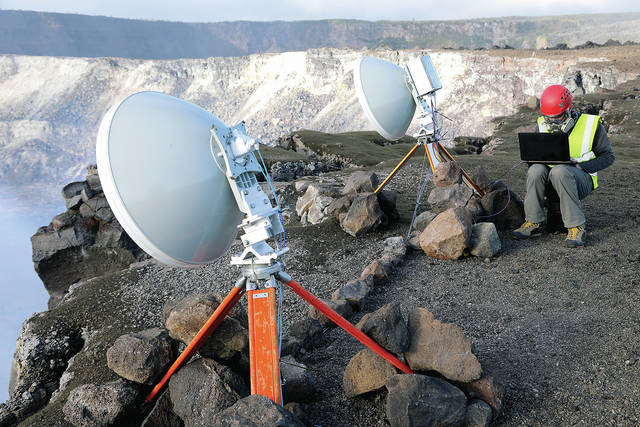A recent issue of Volcano Watch looked at what the level of the lava lake within Halema‘uma‘u can tell us about how Kilauea works and the hazards it poses. The level varies continuously and in concert with both deep and shallow changes in the magma plumbing system feeding the lava lake. One way of thinking about it is that the lava lake acts as a pressure gauge on the magma chamber to which it is connected.
Thomas Jaggar, founder of the Hawaiian Volcano Observatory, was perhaps the first to recognize the significance of lava lake level when, more than a century ago, he established a routine of measuring it at Halema‘uma‘u using traditional surveying equipment. His measurements charted the fluctuating lake level for over a decade until the lava drained away in 1924.
Despite Jaggar’s success, the fact remains that lava lake level is a surprisingly difficult quantity to measure. No one has put a tide gauge in the lava lake or a ruled depth marker in the crater.
Today, HVO scientists primarily use a laser-rangefinder to calculate the lava lake height, but this requires a clear view into the crater.
Making continuous and consistent measurements, day and night, in all weather, is even more demanding. This challenge has stimulated an international collaboration between HVO scientists and a small team of volcanologists and engineers from the University of Cambridge (Nial Peters and Clive Oppenheimer) and University College London (Paul Brennan).
The United Kingdom team, funded by the Natural Environment Research Council, has been developing a turnkey radar for measuring lava lake height, with the first system tested on Erebus volcano in Antarctica in 2016 under the auspices of the U.S. Antarctic Program. Erebus reaches over 12,000 feet (3,658 m) above sea level, and temperatures, even in summer, can be as low as minus 40 degrees Fahrenheit.
The measurements revealed a remarkable periodic rise and fall of the lava lake, with a single oscillation taking around 10 minutes.
Why Erebus volcano behaves like this is still unclear and laboratory experiments are now underway to simulate the activity and better understand the driving processes.
Trusting that if monitoring equipment can survive such harsh conditions on a remote Antarctic volcano, then it should work in Hawaii, the latest version of the radar was brought for a trial run on Kilauea in January.
The Hawaii volcano and climate threw everything at the instrument — the largest rockfall-induced explosion from the lava lake in over a year, torrential rain, and, of course, copious amounts of acidic gas — and it kept on working. After an initial setup period of a couple of days, the radar ran unsupervised for over a week, recording the level of the lake once per second.
The data collected during this period are still being analyzed, but at a first glance, they look consistent with other measurements made by HVO scientists.
At the same time the radar was running, an infrared spectrometer was positioned at the crater rim to record the composition of gases emitted from the lava lake. How gas accumulates in, or escapes from, the lava lake exerts a strong control on the lake level. Careful comparison of extended observations of lava lake height and gas chemistry promise to reveal yet more detailed insights into the relationships between the supply of magma to the surface, the release of gases, and the variable activity of the lava lake.
Most of all, it is hoped that with some further development, miniaturization and ruggedization, and reduction in power requirements, the radar device could become part of HVO’s operational toolkit for monitoring Kilauea and assessing volcanic hazards.
To this end, the recent campaign represented an invaluable opportunity for the UK team to learn first-hand the challenges of operating instruments in the unique environment of Halema‘uma‘u.
Volcano
activity updates
This past week, Kilauea Volcano’s summit lava lake level fluctuated with summit inflation and deflation, ranging about 20-36 meters (66-118 feet) below the vent rim.
On the East Rift Zone, the 61g lava flow remained active downslope of Pu‘u ‘O‘o, with scattered breakouts on the upper part of the flow field and on
Pulama pali, but no ocean entry. The 61g flows do not pose an immediate threat to nearby communities.
Mauna Loa is not erupting. Rates of deformation and seismicity have not changed significantly over the past week, but persist above long-term background levels.
Only a few small-magnitude earthquakes occurred beneath the volcano, primarily at depths shallower than 13 kilometer (8 miles). The largest was a magnitude-2.0 earthquake in the Mauna Loa summit caldera on March 16.
GPS and InSAR
measurements continue to show slow deformation related to inflation of a magma reservoir beneath the summit and upper Southwest Rift Zone.
No significant changes in volcanic gas release or fumarole temperature were measured.
No earthquakes were reported felt in the Hawaiian Islands this past week.
Please visit HVO’s website (https://volcanoes.usgs.gov/hvo) for past Volcano Watch articles, Kilauea daily eruption updates, Mauna Loa weekly updates, volcano photos, maps, recent earthquake info, and more. Call for summary updates at 967-8862 (Kilauea) or 967-8866 (Mauna Loa). Email questions to askHVO@usgs.gov.
Volcano Watch (https://volcanoes.usgs.gov/hvo/hvo_volcano_watch.html) is a weekly article and activity update written by U.S. Geological Survey Hawaiian Volcano Observatory scientists and affiliates.







What is the length from Niihau to the Big Island in miles? Tip to tip, east to west.